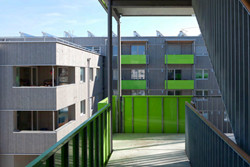New platform guides you through the retrofitting universe
‘The E2REBUILD project platform(opens in new window) brings together the latest retrofitting methods to help builders, housing organisations and architects appreciate that modern industrialised processes can save money by reducing building and energy costs,’ explains project coordinator Dr Christina Claeson-Jonsson, Head of R&D at NCC Construction in Sweden. ‘These processes can also create functional, attractive and individual housing for European citizens, minimise inconveniences for tenants and facilitate more energy-efficient operation and use of buildings.’ The E2REBUILD(opens in new window) (Industrialised energy efficient retrofitting of resident buildings in cold climates) project has also sought to contribute towards improved working conditions on sites designated for retrofitting, and increasing the attractiveness of the industry to potential new workers. The platform can be compared to the technical platforms used, for example, in the automotive industry, which provide a structure for product development, processes and operation. In the retrofitting building sector however, this approach is seldom, if ever, used. The new platform brings together individual results and provides a structure for how energy-efficient retrofitting can best be achieved. A total of seven demonstration building projects in six countries were carried out, and all were completed within the timeframe of the project (E2REBUILD was completed in June 2014). These building sites were used to test a number of energy-efficient retrofitting strategies and to identify how these might contribute towards the establishment of a more holistic way of working. Performance and indoor environment improvements were carefully assessed. A design and decision support tool was developed to matches the needs of end users with these high tech methods. ‘We achieved positive results by not focusing on one product, solution or method alone but rather integrating a number of proposed solutions into one platform,’ says Claeson-Jonsson. ‘This platform can be incrementally improved, and allows adjustments to meet future regulation changes, new technologies and methods.’ Europe’s building industry is currently characterised by on-site production, which can be inefficient with respect to cost and production time. The sector is also negatively associated with poor quality as well as an unsafe and unhealthy working environment. Completion of the E2REBUILD project therefore represents a milestone in transforming the reputation of the retrofitting construction sector and introducing more innovative, high-tech and energy efficient methods. ‘While E2REBUILD has shown that great possibilities exist with an integrated industrialised process and a collaborative way of working, there are still barriers that need to be overcome,’ says Claeson-Jonsson. ‘The whole renovation sector needs to be transformed. Nonetheless, research possibilities can be found in new sustainable materials and processes, the recycling of material and behavioural studies to change the way people work. There is also the possibility for various SMEs (builders and architects for example) to further improve and commercialise the concepts that have been tested through the E2REBUILD project.’ E2REBUILD was a collaborative effort involving 20 partners from eight European countries. Partners included eight architecture bureaux, construction companies and housing companies as well as universities and research institutes.
Countries
Sweden



